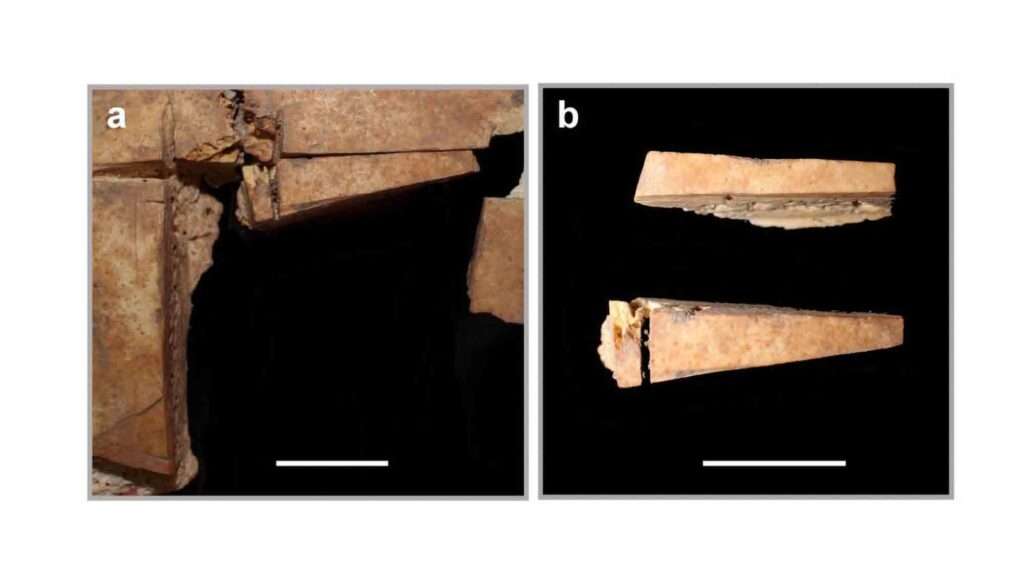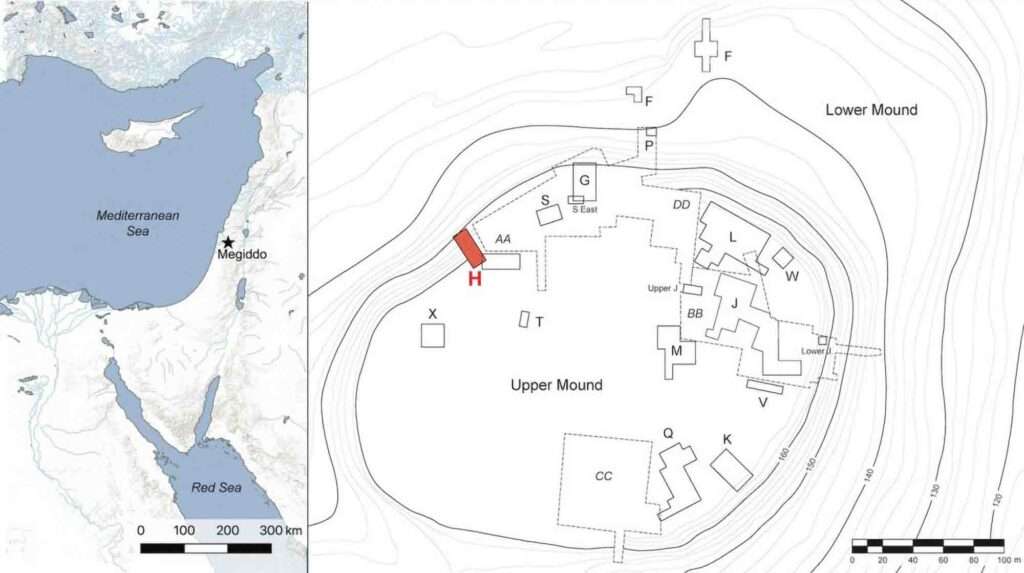Rare brain operations carried out 3,500 years ago on two elite – and perhaps even royal – brothers by Bronze Age surgeons have been revealed by archaeologists.
The skulls of two brothers – who may have been princes – have been found side by side in a tomb with evidence that ancient medics had cut holes in their skulls.
Both brothers, say the experts who unearthed them, are thought to have been suffering from a disease, possibly leprosy.
The remains were unearthed in Megiddo, Israel, by a research team from Brown University, Providence, Rhode Island, USA.
Experts say the surgery – called trephination – led to one of the brothers most likely dying minutes later.

Newsflash obtained a statement and images from Brown University on Wednesday, 22nd February, saying: “A recent excavation in Megiddo, Israel, unearthed the earliest example of a particular type of cranial surgery in the Ancient Near East — and potentially one of the oldest examples of leprosy in the world.
“Archaeologists know that people have practiced cranial trephination, a medical procedure that involves cutting a hole in the skull, for thousands of years. They’ve turned up evidence that ancient civilizations across the globe, from South America to Africa and beyond, performed the surgery.
“Now, thanks to a recent excavation at the ancient city of Megiddo, Israel, there’s new evidence that one particular type of trephination dates back to at least the late Bronze Age.”
The statement added: “Rachel Kalisher is a Ph.D. candidate at Brown’s Joukowsky Institute for Archaeology and the Ancient World.
“Rachel Kalisher, a Ph.D. candidate at Brown University’s Joukowsky Institute for Archaeology and the Ancient World, led an analysis of the excavated remains of two upper-class brothers who lived in Megiddo around the 15th century B.C.
“She found that not long before one of the brothers died, he had undergone a specific type of cranial surgery called angular notched trephination. The procedure involves cutting the scalp, using an instrument with a sharp beveled edge to carve four intersecting lines in the skull, and using leverage to make a square-shaped hole.
“Kalisher said the trephination is the earliest example of its kind found in the Ancient Near East.”
Kalisher said: “We have evidence that trephination has been this universal, widespread type of surgery for thousands of years.

“But in the Near East, we don’t see it so often — there are only about a dozen examples of trephination in this entire region. My hope is that adding more examples to the scholarly record will deepen our field’s understanding of medical care and cultural dynamics in ancient cities in this area.”
The statement said: “Kalisher’s analysis, written in collaboration with scholars in New York, Austria and Israel, was published on Wednesday, Feb. 22, in PLOS ONE.
The statement continued: “Israel Finkelstein, who co-authored the study and serves as director of the School of Archaeology and Maritime Cultures at the University of Haifa, said that 4,000 years ago, Megiddo stood at and controlled part of the Via Maris, an important land route that connected Egypt, Syria, Mesopotamia and Anatolia. As a result, the city had become one of the wealthiest and most cosmopolitan cities in the region by about the 19th century B.C., with an impressive skyline of palaces, temples, fortifications and gates.”
Finkelstein said: “It’s hard to overstate Megiddo’s cultural and economic importance in the late Bronze Age.”
The statement explained: “According to Kalisher, the two brothers whose bones she analyzed came from a domestic area directly adjacent to Megiddo’s late Bronze Age palace, suggesting that the pair were elite members of society and possibly even royals themselves. Many other facts bear that out: The brothers were buried with fine Cypriot pottery and other valuable possessions, and as the trephination demonstrates, they received treatment that likely wouldn’t have been accessible to most citizens of Megiddo.”
Kalisher said: “These brothers were obviously living with some pretty intense pathological circumstances that, in this time, would have been tough to endure without wealth and status.”

She added: “If you’re elite, maybe you don’t have to work as much. If you’re elite, maybe you can eat a special diet. If you’re elite, maybe you’re able to survive a severe illness longer because you have access to care.”
The statement said: “In her analysis, Kalisher spotted several skeletal abnormalities in both brothers. The older brother had an additional cranial suture and an extra molar in one corner of his mouth, suggesting he may have had a congenital syndrome such as Cleidocranial dysplasia. Both of the brothers’ bones show minor evidence of sustained iron deficiency anemia in childhood, which could have impacted their development.
“Those developmental irregularities could explain why the brothers died young, one in his teens or early 20s and the other sometime between his 20s and 40s. But Kalisher said it’s more likely that the two ultimately succumbed to an infectious disease. A third of one brother’s skeleton, and half of the other brother’s, shows porosity, legions and signs of previous inflammation in the membrane covering the bones — which together suggest they had systemic, sustained cases of an infectious disease like tuberculosis or leprosy.”
The statement continued: “Kalisher said that while some skeletal evidence points to leprosy, it’s tough to deduce cases of leprosy using bones alone. She’s currently working with researchers at Germany’s Max Planck Institute for Evolutionary Anthropology to conduct DNA analyses of specific lesions in the bones. If they find bacterial DNA consistent with leprosy, these brothers will be among the earliest documented examples of leprosy in the world.”
Kalisher said: “Leprosy can spread within family units, not just because of the close proximity but also because your susceptibility to the disease is influenced by your genetic landscape.”
She added: “At the same time, leprosy is hard to identify because it affects the bones in stages, which might not happen in the same order or with the same severity for everyone. It’s hard for us to say for sure whether these brothers had leprosy or some other infectious disease.”
The statement said: “It’s also difficult to know, Kalisher said, whether it was the disease, the congenital conditions or something else that prompted one brother to undergo cranial surgery. But there’s one thing she does know: If the angular notched trephination was meant to keep him alive, it didn’t succeed. He died shortly after the surgery — within days, hours or perhaps even minutes.”

The statement continued: “Despite all the evidence of trephination uncovered over the last 200 years, Kalisher said, there’s still much archaeologists don’t know. It’s not clear, for example, why some trephinations are round — suggesting the use of some sort of analog drill — and some are square or triangular. Nor is it clear how common the procedure was in each region, or what ancient peoples were even trying to treat. (Doctors today perform a similar procedure, called a craniotomy, to relieve pressure in the brain.) Kalisher is pursuing a follow-up research project that will investigate trephination across multiple regions and time periods, which she hopes will shed more light on ancient medical practices.”
Kalisher said: “You have to be in a pretty dire place to have a hole cut in your head.
“I’m interested in what we can learn from looking across the scientific literature at every example of trephination in antiquity, comparing and contrasting the circumstances of each person who had the surgery done.”
To find out more about the author, editor or agency that supplied this story – please click below.
Story By: Joseph Golder, Sub-Editor: Marija Stojkoska, Agency: Newsflash
The Ananova page is created by and dedicated to professional, independent freelance journalists. It is a place for us to showcase our work. When our news is sold to our media partners, we will include the link here.




